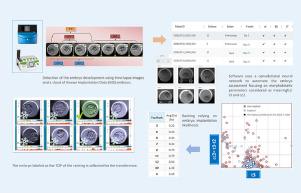Reproductive BioMedicine Online ( IF 3.7 ) Pub Date : 2020-10-10 , DOI: 10.1016/j.rbmo.2020.09.032 Lucía Alegre 1 , Raquel Del Gallego 1 , Lorena Bori 1 , Kevin Loewke 2 , Mahnaz Maddah 2 , Belén Aparicio-Ruiz 1 , Ana Paula Palma-Govea 3 , Julián Marcos 4 , Marcos Meseguer 1

|
Research question
Is embryo selection by Dana (automatic software for embryo evaluation) associated with a higher implantation rate in IVF treatments?
Design
A three-phase study for Dana system's validation: creation of a data-cloud of known implantation data (KID) embryos from 1676 transferred embryos; embryo evaluation by Dana considering manual annotations and embryo development videos (389 transferred embryos); and validation of Dana automatic selection, without embryologist's intervention (147 transferred embryos);
Results
The implantation rate of the 1021 KID embryos from phase 1 served to set four grades of embryos referring to implantation rate: A = 34%, B = 25%, C = 24%, and D = 19%. Phase 2: a classification ranking according to the unit average distance (UAD) and implantation potential was established: top (UAD ≤0.50), high (UAD = 0.51–0.66), medium (UAD = 0.67–1.03) and low (UAD >1.03). Pregnancy rates were 59%, 46%, 36% and 28%, respectively (P < 0.001). Phase 3: embryos were automatically categorized according to Dana's classification ranking. Most implanted embryos were found in groups top, high and medium (UAD ≤1.03), whereas the implantation rate in group low (UAD >1.03) was significantly lower: 46% versus 25%, respectively (P = 0.037). The twin gestation rate was higher when number of top embryos (UAD ≤0.5) transferred were two (52%) versus one (25%) (P < 0.001).
Conclusions
Embryo selection based on Dana ranking increases the success of IVF treatments at least in oocyte donation programmes. The multicentre nature of the study supports its applicability at different clinics, standardizing the embryo development's interpretation. Dana's innovation is that the system increases its accuracy as the database grows.
中文翻译:

使用基于云的自动软件评估胚胎植入潜力
研究问题
Dana(用于胚胎评估的自动软件)进行的胚胎选择是否与 IVF 治疗中较高的植入率有关?
设计
Dana 系统验证的三阶段研究:从 1676 个移植胚胎中创建已知植入数据 (KID) 胚胎的数据云;Dana 考虑手动注释和胚胎发育视频(389 个移植胚胎)对胚胎进行评估;验证 Dana 自动选择,无需胚胎学家干预(147 个移植胚胎);
结果
第一阶段的 1021 个 KID 胚胎的着床率用于设定胚胎的四个等级,参考着床率:A = 34%、B = 25%、C = 24% 和 D = 19%。阶段 2:根据单位平均距离 (UAD) 和植入潜力建立分类排名:顶级 (UAD ≤0.50)、高 (UAD = 0.51–0.66)、中 (UAD = 0.67–1.03) 和低 (UAD > 1.03)。妊娠率分别为 59%、46%、36% 和 28% ( P < 0.001)。第 3 阶段:根据 Dana 的分类排名自动对胚胎进行分类。大多数植入胚胎出现在高组和中组(UAD ≤1.03),而低组(UAD >1.03)的着床率显着较低:分别为46%和25%(P = 0.037)。当移植的顶级胚胎数(UAD ≤0.5)为两个(52%)比一个(25%)时,双胎妊娠率更高(P <0.001)。
结论
至少在卵母细胞捐赠计划中,基于 Dana 排名的胚胎选择提高了 IVF 治疗的成功率。该研究的多中心性质支持其在不同诊所的适用性,标准化胚胎发育的解释。Dana 的创新在于该系统随着数据库的增长而提高其准确性。











































 京公网安备 11010802027423号
京公网安备 11010802027423号